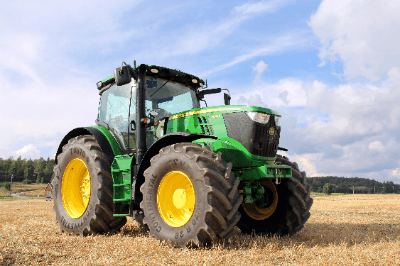What Is a Tractor?

A tractor is a vehicle designed to tow non-powered implements.
Primarily used in construction and agriculture, tractors vary in size and horsepower depending on the implement being towed. Trailers for transporting goods are also a type of tractor, characterized by the independent existence of the towing vehicle and the cargo-carrying section.
Fuel selection is adaptable based on the application, with compatibility for diesel or gasoline. By changing the implement, a single tractor can perform various tasks. Particularly in agriculture, tractors have been in use since the early 19th century, and their development has continued to the present day.
Uses of Tractors
1. Agriculture
In rice or crop cultivation, horsepower is selected based on the size of the farmland. The common usage involves the combination of a tractor and a specific implement.
Various implements have been developed in response to the numerous farming processes and are widely used. In agriculture, where challenges such as an aging population and a shortage of successors are present, efficiency in operations becomes a significant theme, with tractors playing a crucial role.
Specific agricultural applications include:
Plowing
Implements such as rotaries or plows are used for field cultivation. Rotaries rotate rows of tines to till the soil, while plows turn the soil in an up-and-down motion, mixing and creating a base soil structure.
Seeding
Seeding is performed using a seeding machine. Models vary based on seed size, aiming to optimize the seeding depth, a critical factor affecting crop growth.
Spraying
Boom sprayers are utilized for widespread pesticide and chemical application. This device sprays agents from boom-style nozzles while the tractor moves, ensuring even coverage over crops. The development of mechanisms to reduce chemical loss is ongoing, with consideration for both environmental impact and adherence to pesticide regulations.
Fertilizing
Lime spreaders and broadcasters are used for fertilizer application. Many lime spreaders employ power take-off (PTO) drives in various models, allowing for uniform fertilizer spreading, especially with powdered or pelletized fertilizers. Broadcasters, using the centrifugal force of a built-in rotating disc, can cover a wide area but may have challenges in precision. Both types are not suitable for liquid fertilizers.
Harvesting
Combines or harvesters are employed for harvesting operations. These machines can separate edible parts from unwanted portions, and some allow for external discharge.
2. Construction Operations
To enhance the efficiency of construction operations, various implements have been developed. Tractors can handle tasks ranging from excavation to soil transport and paving, expanding their versatility.
3. Forestry
In forestry, tractors are used for securing footholds and transporting thinned wood. Models capable of progressing on slopes and challenging terrains are highly valued.
4. Logistics
By utilizing trailers, tractors can cover long distances and transport large quantities. The cargo-carrying containers are often interchangeable between different tractors, contributing to smooth logistics operations. To facilitate connection and disconnection, the tractor is equipped with a connector called a coupler, while the trailer features a large pin known as the kingpin. This setup eliminates the need for unloading, reducing the burden on workers. Tractors can also transport automobiles and heavy machinery, making them cost-effective.
Principles of Tractors
Due to their structural design with implements attached to the rear, tractors tend to have a rearward-biased center of gravity. Countermeasures include attaching weighty components to the front to adjust the balance. To navigate challenging terrains, tractors are equipped with crawler tires.
Other Information on Tractors
Unmanned Tractors
In response to labor shortages in agriculture, expectations for unmanned tractors are significant, and various companies are actively developing them. Field trials, including pesticide spraying using flying drones, are conducted, emphasizing the diversification of roles and the utilization of AI.
Current challenges include the deployment of infrastructure enabling high-speed data communication, cost issues related to the tractor itself, and legal interpretations during on-road travel. Nevertheless, the market size is expanding yearly, urging the realization of “smart agriculture.”